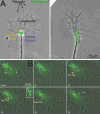The role of mitochondria in axon development and regeneration
- PMID: 29030922
- PMCID: PMC5816701
- DOI: 10.1002/dneu.22546
The role of mitochondria in axon development and regeneration
Abstract
Mitochondria are dynamic organelles that undergo transport, fission, and fusion. The three main functions of mitochondria are to generate ATP, buffer cytosolic calcium, and generate reactive oxygen species. A large body of evidence indicates that mitochondria are either primary targets for neurological disease states and nervous system injury, or are major contributors to the ensuing pathologies. However, the roles of mitochondria in the development and regeneration of axons have just begun to be elucidated. Advances in the understanding of the functional roles of mitochondria in neurons had been largely impeded by insufficient knowledge regarding the molecular mechanisms that regulate mitochondrial transport, stalling, fission/fusion, and a paucity of approaches to image and analyze mitochondria in living axons at the level of the single mitochondrion. However, technical advances in the imaging and analysis of mitochondria in living neurons and significant insights into the mechanisms that regulate mitochondrial dynamics have allowed the field to advance. Mitochondria have now been attributed important roles in the mechanism of axon extension, regeneration, and axon branching. The availability of new experimental tools is expected to rapidly increase our understanding of the functions of axonal mitochondria during both development and later regenerative attempts. © 2017 Wiley Periodicals, Inc. Develop Neurobiol 78: 221-237, 2018.
Keywords: growth cone; mitochondrion; organelle.
© 2017 Wiley Periodicals, Inc.
Conflict of interest statement
The authors do not have any conflicts of interests to disclose.
Figures




References
-
- Arismendi-Morillo G, Hoa NT, Ge L, Jadus MR. Mitochondrial network in glioma's invadopodia displays an activated state both in situ and in vitro: potential functional implications. Ultrastruct Pathol. 2012;36:409–14. - PubMed
Publication types
MeSH terms
Grants and funding
LinkOut - more resources
Full Text Sources
Other Literature Sources

